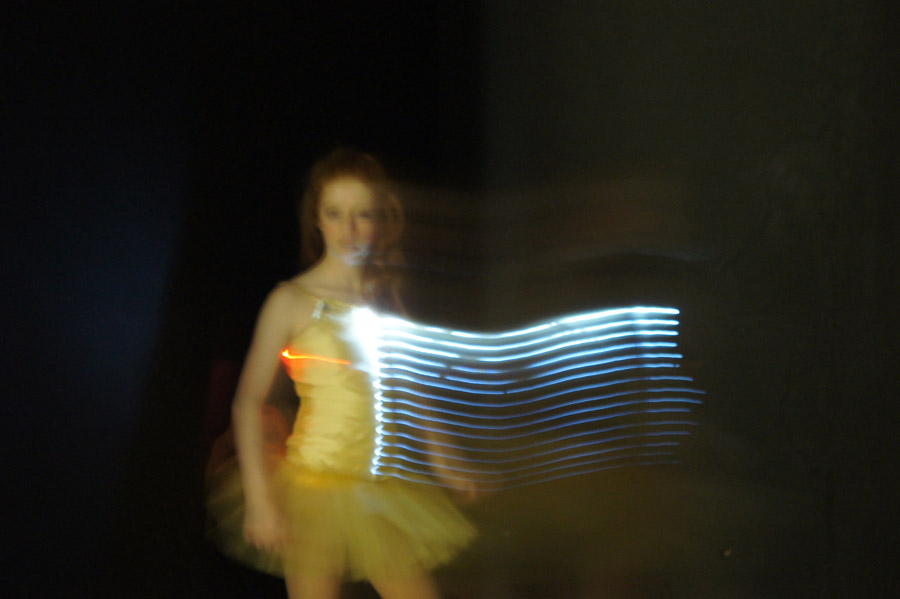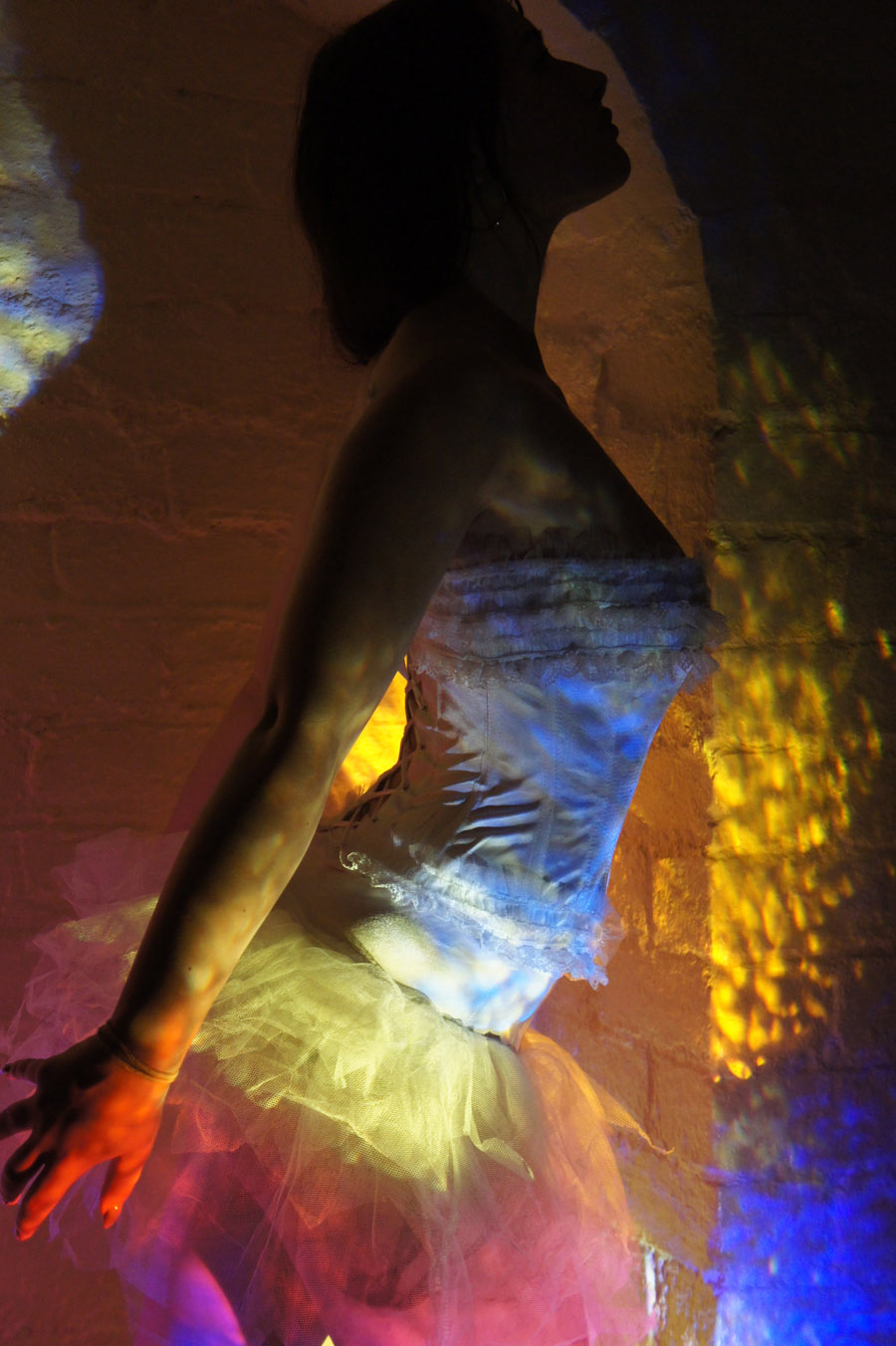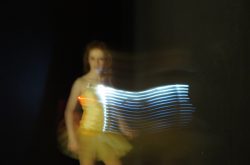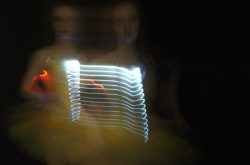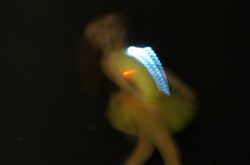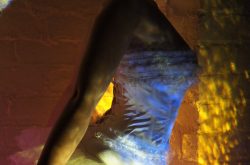Karen could not help it, she was obliged to dance a few steps; and when she had once begun, her legs continued to dance. It seemed as if the shoes had got power over them… she danced, and was obliged to dance, far out into the dark wood – The Red Shoes, Hans Christian Andersen
Across the arts, the image of the tutu-clad ballerina has come to epitomise elegance, grace and beauty. At the same time, she has also been associated with an undercurrent of disorder and darkness. In many stories this duality – within the ballet dancer – marks ‘a coming of age’, and journey from girl to woman. With reference to Edgar Degas’ adolescent dancers, Sophie Hedderwick’s mesmerising exhibition ‘Swift as a Shadow’ explores the representation of female youth and femininity as the ballerina’s body moves across time and space.
Hedderwick’s exhibition – made up of large format digital prints, Polaroid collections and a video installation, was inspired by Degas’ renowned ‘Little Dancer Aged Fourteen’. Degas’ diminutive sculpture caused much controversy amongst viewers and critics when it was shown at the 1881 Impressionist Exhibition in Paris. Far removed from traditional, idealized sculptures of women in marble, Degas’ realism depicted the physiognomy of his model’s body. This made uncomfortable viewing for many male critics, who denounced the ballerina for her “bestial effrontery” and “vicious character”. Bringing centre stage a working-class girl, what Degas had also challenged was the social corruption of the Paris Opera where the young dancers (‘petits rats’) were assigned patrons who managed them both socially and sexually.
Taking Degas’ ‘Young Dancer Aged Fourteen’ as my inspiration I will explore this provocative pose and relate it to contemporary art – Sophie Hedderwick
In ‘Swift As A Shadow’ Hedderwick explores the contentious pose and significance of the original sculpture through photographing a contemporary ballet dancer in a series of movements. By recording light traces from LED lights sewn onto the dancer’s costume, the multi-layered, contemporary images are both beautiful whilst challenging in their representation of youth. Particularly striking are the photographs printed onto black, brushed aluminium. In works such as ‘Young Dancer Aged 14:2’ figures fluently emerge from the camera’s long exposure, appearing in a multiplicity of arched poses, and illuminated with light. The patterns of light, which make bare the silver aluminium, define and echo the frame of the figure’s rib cage and skeleton. Images such as ‘Young Dancer Aged 14:3’ also reference Degas’ lesser-known, photographs in which lamp-lit figures emerge, blurred, from the darkness, imbued with a psychological quality.
Hedderwick explains that the photographs on show are also “very personal”. They feature her daughter Catlin, a keen dancer, and her transition, from the age of fourteen to seventeen. Her practice belongs to a tradition emerging within contemporary female photography, which deals with imagery of young female bodies on the verge of adulthood. In particular, she explains that she took inspiration from the black and white photographs of Sally Mann in her collection ‘At Twelve’. In this body of work, Mann created photo-portraits of twelve-year-old girls from her hometown in Virginia. These large-format photographs were Mann’s intimate study of girlhood and the transition into adulthood. Like Mann, there is real strength and dignity to Hedderwick’s images, in which dancers have an awareness of their body and identity.
Hedderwick’s daughter also features in a film included in the show, in which the artist captures her at different ages, moving from childhood to adolescence. The film makes prominent the motifs and attributes of femininity, with close-up shots of the ballerina’s traditional tutu, her long, loose hair and pointed toes in pastel ballet shoes. With this focus, the film aligns itself with the work of the female Surrealists; the likes of Dorothea Tanning, Lee Miller and Leonora Carrington intimately reclaimed the image of the woman – beyond her role as muse – to play out notions of male fetishes and desires. The film also plays with the notions of time and memory, and its dream-state quality again creates a surrealist world, in which the ‘coming of age’ can be explored and made accessible to viewers.
The ‘coming of age’ theme carries throughout the exhibition. As well as using her daughter as a model, Hedderwick used a twenty-one-year-old model for two of the photographs: ‘Young Dancer: Aged 21:1’ and ‘Young Dancer: Aged 21:2’. She is dressed in attire indicative of femininity, laced up in a bodice and with ribbons adorning her hair and the splaying frills of a tutu framing her legs. At the same time, sensuality is balanced by vigour and strength; the viewer’s eye is drawn to her long, painted nails and the tattoo, just evident, on her right leg. These photos recall Toulouse Lautrec’s humanistic paintings of dance hall performers, defined by their multi-coloured artificial lights and unusual angles, evoking the effect of a performance, whilst capturing the woman behind the costume.
In this evocative, feminist body of work, Hedderwick reconfigures the territory of the ballerina’s body in a bold exploration of femininity. Reclaiming a traditional art historical subject associated with male artists, most notably Degas, she reworks it in a strikingly contemporary manner, and from a female point of view. This body of work is simultaneously personal, and universal; the enticing figure has been photographed by a female artist, woman, and mother. Poised between girl and woman, the ballerina is allowed to play out her ‘coming of age’ on a spellbinding stage.
Sophie Hedderwick is currently an AHRC funded PhD researcher at Birmingham School of Art. Her thesis is entitled ‘Beyond sensors, de-coding the curve of the young female body; feminism and polymorphous performance art in the age of digital tran-sformation’. Her work has been exhibited worldwide including London, New York, Tokyo, Milan and at the Venice Art Biennale (2009).
Sophie Hedderwick’s exhibition ‘Swift As A Shadow’ runs from 17th February – 25th March 2017 at Argentea Gallery, which is dedicated to bringing the very best contemporary photography from both British and international artists to Birmingham.
Article by Ruth Millington: www.ruthmillington.co.uk

